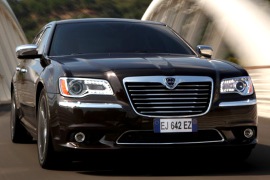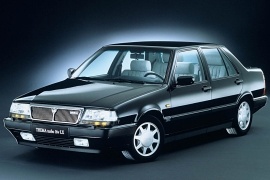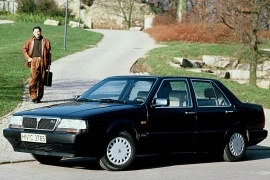LANCIA Thema Models/Series Timeline, Specifications & Photos
First production year: 1984
Engines: Diesel, Gasoline
After joining forces with Chrysler, Lancia started to produce the Thema for the European market based on the same platform as the Chrysler 300.
Lancia was no longer an important brand in the European market. Still, the carmaker tried to survive with some help from its parent company, Fiat. So, after the Italian company inked a deal with Chrysler to form an alliance, Lancia got another chance. It used a renowned nameplate, the Thema, and installed it on a badge-engineered vehicle that was known in the U.S. as Chrysler 300. Unfortunately, the European customers knew that car too from the era when the American brand was part of the DaimlerChrysler group, so there were not too many buyers for that elegant vehicle.
The reason for a badge-engineered car is to lower, and split production costs among several brands, and one of the ideas was to add minimum changes between the twin vehicles. Lancia, on the other hand, tried a little bit more and reshaped the front fascia of the Thema. Thus, the shield-like chromed grille resembled some of the pre-WWII vehicles made by the Italian brand. Yet, the headlights had to keep the same shape as on its American brother, with a larger outer side and integrated blinkers into the headlamps. The rest of the vehicle looked the same, with a low roof line and short windows.
Inside, the rounded-shaped dashboard featured an arched visor above the instrument cluster filled with two large dials that flanked an LCD between them for the car's onboard computer information. Thanks to its wide, comfortable seats, the Thema was one of the best long-distance cruisers that wore an Italian badge at the front. In the back, it was enough room for three adults, but the middle-seated one had to sit above the transmission tunnel.
Under the hood, Lancia installed a choice of two engines: a 3.6-liter V6 carried over from Chrysler and a 3.0-liter turbo-diesel made by VM Motori. Both versions were paired with a five-speed automatic.
The Thema was close to its final years, but the Italian carmaker was not ready to change it and kept it running until 1995 when it switched to the Kappa lineup.
By 1992, the Thema was already eight years old on the market, and that, from those times standards, made it an old model. Fiat, who owned the Lancia brand since 1969, wasn't ready to introduce a new generation so it ordered its engineers and designers to work on the car and keep the Thema on the assembly line for a couple of years more. And they did.
The Thema struggled to survive and showed its age on its flat and dull trapezoidal grille. Its rectangular headlights were reshaped, and that gave the car a better image from the front. But there was nothing to do with the bodywork's boxy-style, a style that other carmakers already replaced.
Inside, the Thema was roomy for four passengers, with plenty of room for the front occupants. But in the rear, it was better only for two. Since it was built on the same platform as the Alfa Romeo 164, it featured a center tunnel that was too intrusive for three passengers. Its wood-trims and the open storage area in front of the passenger seat helped it score some points in the comfort department.
Under the hood, Lancia kept its 2.0-liter engines and added the 3.0-liter V6 from the Alfa Romeo 164. Neither of them was paired to an automatic transmission. The performances were good for those times and kept the Lancia spirit alive among those who enjoyed spirited driving but needed a large vehicle.
Based on the same platform as the Alfa Romeo 164 and the Saab 9000, the Lancia Thema was the most luxurious model in Lancia's lineup.
By the end of the '80s, Lancia was on the verge. In 1984, the Italian carmaker introduced the Thema as the up-market representative. It was the first vehicle built on the Fiat/Saab platform, and it replaced the unsuccessful Lancia Gamma.
The refreshed version featured a new set of narrow headlights and a sharp-looking grille. Its subtle turn-signals placed just above the bumper were hard to be noticed at night, but they were as legal as they could. The Italians didn't want to spoil the look for regulation's sake! In the rear, the taillights were mounted only at the back of the quarter panels. The top version, named 8.32, featured a retractable wing activated via a button inside the cabin.
Depending on the trim level, the Thema could have offered a simple interior or a luxurious one. From regular cloth to expensive leather, Lancia could offer almost any kind of upholstery. While the base models featured black plastic trims, the upper trim levels featured wood-trim on the dash and door panels. Like the rest of the vehicles built on that platform, Thema offered a decent amount of room in the back for up to three occupants, although the high center tunnel was too intrusive for the middle passenger.
Lancia offered the Thema with a wide choice of engines. After 1988, it installed twin-cam engines with four valves per cylinder. There were a few special versions, such as the Turbo with all-wheel-drive and the top model 8.32. The latter used a Ferrari 308 GTB engine and could keep up with most of the supercars from its era. It was a genuine factory sleeper.
Fiat and General Motors developed a platform for four distinct-looking vehicles: the Saab 9000, Fiat Croma, Alfa Romeo 164, and Lancia Thema.
While Saab introduced steel beams in the doors for enhanced protection, and Alfa Romeo took only the platform, Fiat and Lancia rushed the project to the production lines. The Thema was more of an upmarket three-box sedan with wedged-styling penned by Giugiaro.
At the front, the carmaker followed the squared-looking overall design and installed rectangular headlights and a Lancia-specific split grille. Its wrapped-around plastic bumper included a set of fog lights, available as an option or standard depending on the version and trim level. The chromed flush door handles and body-colored door mirrors confirmed the car's premium level from its sides. For the top-of-the-line 8.32 version, Lancia installed a retractable wing-spoiler on top of the trunk.
Inside, Lancia offered the Thema with either a cloth upholstery or a leather-clad interior. Its squared-looking instrument panel sported two large dials and two gauges, complemented on the center stack by three additional gauges depending on the engine version. Since it was a large vehicle, it could accommodate five occupants inside. Unusually for its class on those times was the folding rear bench, which expanded the 440 liters (15.5 cu-ft) trunk to 1,000 liters (35.3 cu-ft).
Under the hood, the carmaker offered a wide engine choice between 101 hp and 215 hp. Ferrari provided the 2.9-liter V-8 unit, and it was carried over from the Dino and enhanced for Thema.



